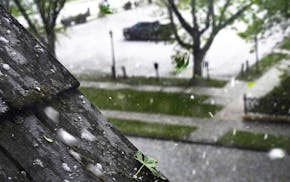In her push to make Minneapolis more equitable, Mayor Betsy Hodges is turning her attention to the group facing the city's greatest disparities in wealth, employment and education.
Since she was elected more than a year ago, the mayor has made a point to spend time with American Indian organizations. She gave her first state of the city address at the Minneapolis American Indian Center and she's participated in cultural events along Franklin Avenue, the cultural hub for the city's Indian population.
And late last year, Hodges began making good on a promise she'd made to a tribal leader: that she'd visit each of the offices that function like embassies for members of different tribal nations living in the Twin Cities.
Hodges' effort marks the most significant mayoral outreach to the city's Indian community in recent history.
"It's a 'getting-to-know-you,' first off," Hodges said of the visits. "It's them sharing with me what work they're doing, what their priorities are, the services they provide their members, and then having a conversation about where we can work together."
Tribal leaders say Hodges' drop-ins have surprised many in the community, who have often felt overlooked by city leaders or wary of politicians. They say it's the first time a mayor has requested to meet at the urban offices.
The visits — four so far, with two more planned this winter — have left those leaders feeling encouraged.
"If you know the right people I think you can hurdle over some of the obstacles in getting resources," said Barb Benjamin-Robertson, urban office director for the Mille Lacs Band of Ojibwe. "I was so excited after [Hodges] left."
In addition to the Mille Lacs office, Hodges has visited those of the Boise Forte, Fond du Lac, and Red Lake tribes. Still on the list are Leech Lake and White Earth.
The urban offices help direct tribal members to local government and nonprofit services of all kinds. Benjamin-Robertson, whose office serves about 400 households in the Twin Cities, said the needs are often great.
"Some people need assistance with just cost of living expenses, food, shelter," she said.
The disparities between white residents and minorities that Hodges often references are particularly stark for Indians, who have the highest poverty rate of any group in Minneapolis.
Census data from 2011 put the Indian poverty rate at just over 53 percent. The city's overall poverty rate was close to 24 percent. Meanwhile, the most recent four-year graduation rate for Indians enrolled in Minneapolis public schools was just under 34 percent, the lowest of any racial group. Overall, about 54 percent of Minneapolis students graduated in four years.
Toni Stillday, an ambassador with the Red Lake urban office, said the mayor's visit has helped spark brainstorming about matching up the services offered by the city and other groups with those of the tribes.
Her office serves about 2,000 people in the metro area.
"The overarching goal would be to establish a relationship and to look at creating housing opportunities, better education opportunities and meet transportation needs, in terms of our membership," she said. "But also creating partnerships for business opportunities."
Former City Council member Robert Lilligren, a member of the White Earth Band of Ojibwe and president and CEO of Little Earth of United Tribes Housing Corporation, said the relationship between the city and Indians has tended to be a "reactionary" one.
In the past, he said, members of the community would do most of their interacting with officials after some kind of negative event, perhaps protesting someone's treatment by the police, or a lack of affordable housing.
After he was elected to the council in 2001, Lilligren said he worked to broaden the connection. The city signed a memorandum of understanding with an organization of tribal leaders, and the city sometimes held meetings with tribal governments.
But Lilligren said the extent of the mayor's interest appears to go beyond what the city's done so far.
"She's doing it differently than any mayor before her has," he said.
Peggy Flanagan, also a White Earth tribal member and a board member of the Native American Community Development Institute, said tribal members have taken note of Hodges' support for protests against the Washington NFL team's mascot and the council vote to transform Columbus Day into Indigenous Peoples Day.
Now, she said, it's a matter of what American Indian groups decide to do with the increased interest from the city's leader.
"I think the solution itself needs to come from the community," she said.
Erin Golden • 612-673-4790

Why do so many Minnesota homeowners get free roofs after a hailstorm?
Minnesota state parks press on with camping reservation system tweaks

A plume of PFAS chemicals under the east metro is moving. The state has a new plan to stop it.

Andover High School teacher leads effort for more understandable driver's tests

